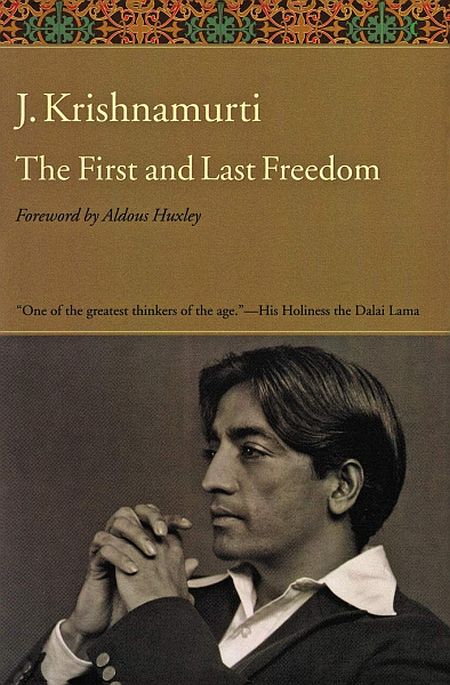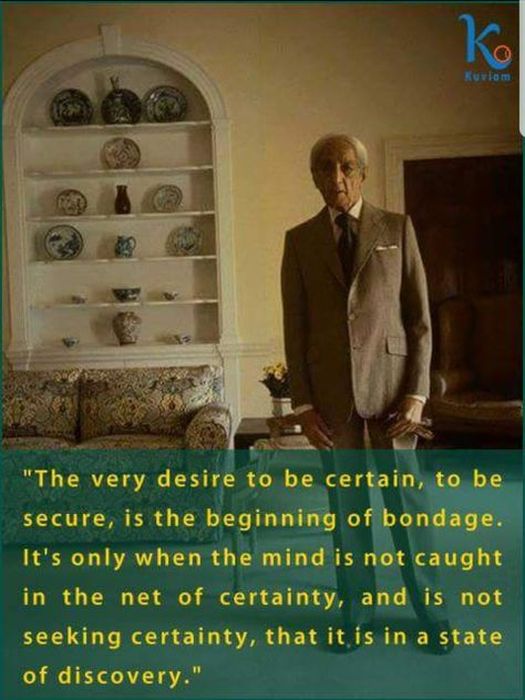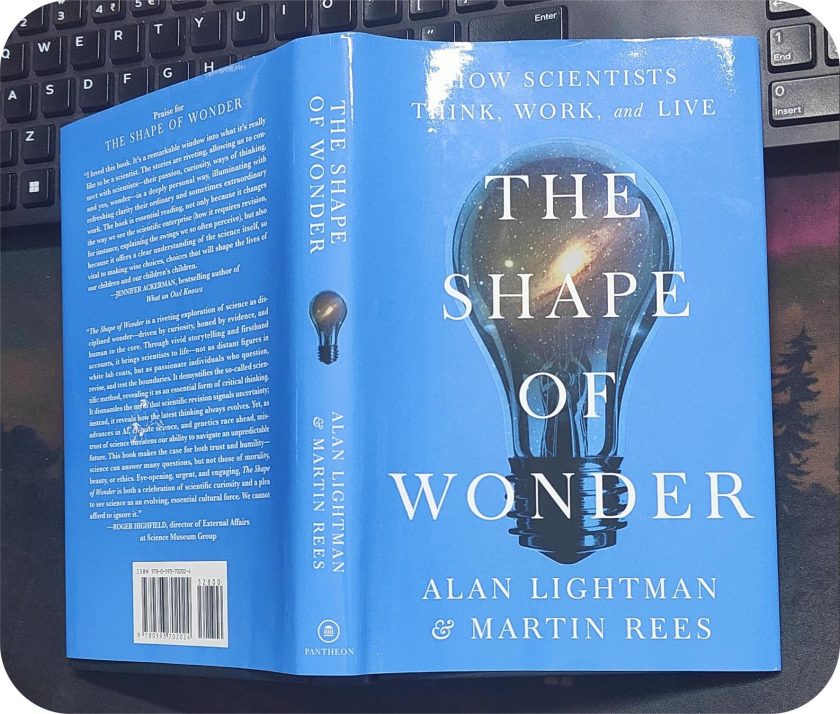
This is the second in series of the book review. In case you haven’t read the previous part, you may find it here, The First and Last Freedom by J. Krishnamurti (I/II).
In the first ten chapters, Krishnamurti is discussing about the inner workings of the mind. He says that we humans are a product of our own thoughts. We are fixed in a self-created patterns called thoughts. In a bigger picture we forget that thoughts are nothing but the events of past time. So, the only way to break free is to live in the present moment by observing constantly the way how our mind process information and surface desires.
XI) Awareness
To know ourselves means our relationship with the world, including,
- people
- our behaviour
- things that we possess
- nature
- animals
No life is without relationship. Relationship does not mean isolation. In contrast, life itself demands awareness, that is full recognition, of the total process of relationship.
Identification leads to pleasure and pain. Similarly, identification of oneself leads to awareness. And awareness of oneself can be tested in the:
- action of relationship
- way we talk
- way we behave
Therefore, watching oneself without an identification, without any condemnation, without any comparison will give totally a different outlook. It will also put an end to unconscious activity. Nothing will then be operated in default mode.
Awareness is all about looking at the larger picture as a whole, without any slightest element of condemnation. Mere observation with full awareness leads to freedom. As we begin to know oneself with respect to a problem, the awareness will surface the process of our own thinking, and in that, there is a release.
XII) Desire
Desires are never ending. We think by substituting one desire with other, we will feel happy/satisfied. But this never happens. Rather, in this movement of one desire to another, there is a constant struggle and thus, the conflict of opposites.
So, we need to understand, what is desire? “It is sensation with the object and its attainment”.
Mind is always directed/running towards further sensations. Thus, mind becomes mechanical instrument of this process. And this process revolves around me or the self, that is the centre of desire.
Can it be dissolve? We/our mind is constantly in the clutches of sensation and memories. Even if mind wants to have a new experience, it’ll be in form of sensations only. Any new experience, even if its creative, our mind reduces it to mere sensation, which in due course of time becomes a memory. That is how it stores information – past and present both.
Therefore, experience is dead and mind becomes a stagnate pool of past. Thus, it seems incapable for us to transcend the mind.
So, how can we go beyond all this? By understanding the whole process of desire.
We can never understand the mind simple because it is a product of past events/memories. Some think that by limiting our wants and assets we can reduce our desires. But what about the inner cravings, struggles, beliefs? Hence, it has to start from within and move towards the outside.
Mind can never produce any new sensation; it can never experience anything new because its approach is always through memory. Anything that is recognised through memory can never be true, it can never be the Reality. Therefore, the only way to break the pattern is to understand the entire process of desire.
XIII) Relationship and isolation
“Life is an experience, experience in relationship.” Relationship is like a mirror where we discover ourselves. Therefore, our existence depends on relationships and it is the lack of understanding of relationship that causes conflict.
We believe that relationship is a means of further achievement but this is not the case. It is a means of self-discovery, because relationship is “to be”. “It is existence!”
It is not a process in isolation, as we see it. As long as a relationship is gratifying us, we are related to someone. But when there is disturbance, we discard that relationship. Today we see that people have developed resistance, they have created walls and see relationship from above the wall. We have enclosed ourselves and think that by living in enclosure we are safe, secure and happy.
World is full of suffering so by living within our own psychological barrier we feel we are safe and talk about peace and common brotherhood. There cannot be peace in the world. Process of isolation can never lead to peace and prosperity. Relationship is a process of self-realisation and without knowing oneself, via understanding the process of mind, any outward system of ideologies and cultural traditions has no meaning.
XIV) The thinker and the thought
As long as there are two states, there cannot be reconciliation. Thinker is thinking the thought. So, the two entities (by default) are – thinker and thought. Effort must be made to bridge the two.
This dualistic approach can only be resolved when one directly experience the state in which the thinker is the thought. Mere act of thinking is becoming more like that or less like that. And in this struggle, there is always a deteriorating factor.
This problem can only be resolved by creative process. There is no “I” dominating, no desire to become this or to become that. It is not a matter of reading or desiring to become good, rather it is a state of direct experience. This requires enormous great understanding of the working of the mind. Since, it is the mind that creates the divide.
XV) Can thinking solve our problems?
No, thinking can never solve our problems because thinking is a reaction. Any reaction/response is due to memory, prejudice, biases, upbringing, conditioning, climate to name a few. And this entire process occurs on the background of “me.”
Thought can never see a complete picture, therefore, it can never be solution oriented. More we think, analyze, discuss about any problem, the more complex it becomes.
If the center, the “me” with its desire for power, position, authority, self-preservation become non-existent then our problem too comes to an end.
Being aware of the process of our own thinking and realising that it (thinking) actually leads to nowhere is a state of highest intelligence, which is not individual or collective.
This does not mean arriving at somewhere or becoming something. It, rather, is a state of being that can only be understood through the awareness/constant alertness of the process that we call thinking.
To understand any problem, one needs to have a still and quiet mind. Then mind will look at the problem without imposing any ideas or predefined notion. Such a mind is not a result of practice or control. It occurs when one understands the whole process of thinking, that is, seeing a fact without any distraction.
XVI) The function of mind
Observation of the working of the mind is done by not superimposing what it should do or how it should think or act. Investigation of the mind has to be done in a subjective manner, quoting others or following other person’s thought process would put an end to all pursuits.
Function of mind is to think. And thinking is a process of isolation because thinking is based on memories, prejudices, conditioning etc. All these are the ways of intellect, where the importance is given to the self. Discipline, knowledge, control all these further give importance to the self, the me within, which one feels is superior to others or vice versa.
Giving preference to self is not the way of love. When one loves, it leads to cooperation and then one transcends oneself. That is called intelligence. There is no vested interest in love.
When there is no mind with its intellectual subtleties there is love. Trying to find the truth through intellect/mind/self is idolatry. When there is no self, the timeless, eternal comes into being.
XVII) Self-deception
Delusions are created by the mind. This cannot be resolved at the verbal level. Historians, theologians and religious people have explained the whys and hows of wars, yet the wars have happened.
Therefore, the need of the hour is to seek revolution at the fundamental level than seeking outside, that is, within ourselves.
We are constantly deceiving ourselves and accordingly spread it to the world. Why do we deceive ourself? It gives us a sense of security, a desire to be well thought of, a desire to have position, prestige, power etc.
First, we create delusion and then we become slaves to it. Why? Because we have a constant desire to be something in this world. This is the most difficult thing for the mind to be free from.
When one reaches a state when one doesn’t want any “certification” from the world – its like, living in the world and be nothing – then mind will not seek any result or security in any kind, even in relationships. It will then work with unison with others. There will be cooperation.
It is only when the mind understands the whole process of desire that it can be still. It is then in a state where there is no deception of any kind.
XVIII) Self-centred activity
It is a form of identification with everything around us, that is, country, ideology, any particular group (religious, profession, peer), identification with results, pursuit of virtue and so on.
Identification with all these is self-imposed or influenced and guided by some other person or his ideals. All these voluntarily activities must come to an end. Self-centred activities only create chaos and mischief at the ground level although from the outside it looks like a unifying process.
XIX) Time and transformation
Significance of timelessness can only be experienced when we understand the whole process of time. We as humans understand time not only in chronological sequence but also in a sense of psychological memory.
Our mind is a product of memories, which is of past years. Without time we cannot think. Memory is time. Thought process brings about psychological progress in time but it is not real. And from the mind’s time, we can never understand the eternal, the timeless.
For instance, happiness is not the product of time, it is always in the present moment therefore, it is a timeless state. Just like listening to music is an act of present continuum. Discipling the mind in the time by practice or by meditation can never reveal that which is timeless.
Is transformation a matter of time? No, it can never be.
We are conditioned to think that with time we can undergo transformation. By regular exercise, we can keep our body fit. But it cannot alter the intrinsic qualities. In time, we cannot transform from being greedy to kind. Or from being violent to gentle person. We can’t say that for thirty days I will not be greedy or violent and so by the thirty first day I’ll be a transformed person.
During the set time duration, one is already in conflict. Resistance creates psychological disturbance, which is violence itself. Mere thought that time will heal and by doing the act of resistance will not work for the long run. So, the only way to understand a conflict is to have a quiet mind. To understand a conflict, one does not need to depend upon time. Simply confront what “is”.
Immediately there comes a quietness, a stillness of mind. In that alert yet passive mind, there is an understanding, which is absent in conflict, blaming, resisting, condemning state of mind.
XX) Power and realization
Radical changes are not made by following certain patterns originated by the mind because it’ll be still within the field of mind.
If we continue to follow it, then it’ll mean that we humans are merely creations of the mind. All the conformities, disciplines, control only strengthens the “me”. So, what am I to do?
To understand this, we need to understand what consciousness is. It is the thinking level, thought.
Thought is the result of memory. Memory is storing of information and extricating from mind’s database as and when required. Also, we have numerous inhibitors, controls and discipline at this level. Going a li’l deeper from here we have hidden motives, desires, prejudices, biases etc. All these are result of perception, atmosphere and contact.
This entire consciousness is centered around the idea of “me”, the self.
So, if we need to have change, we need to work on both superficial as well as deeper levels. However, there is always an ongoing conflict going on at both the levels.
In order to bring about a creative revolution within ourself, we have let’s say tried various disciplines and followed pursuits of ideals about God and God realisation. We have postulated that there is one Reality and developed theories fitting around the postulation. Built beliefs, assumptions and accordingly we have lived by. Does it in any way bring about the radical change within us?
Until and unless we have experienced the transcendental reality, what is the good of speculating or imagining we are the essence of the immortal? That is still with the field of thought and anything that springs from thought is conditioned of time, memory and therefore not real.
It can only be experienced by a still, quiet yet alert mind because mind in that state is not pursuing any idea.
When mind is pursuing or thinking about something, then there is duality – thinker and the thought.
When the thinker is not controlling the thought, that experience alone realises the creative energy, which brings about the fundamental revolution. Then there is no me/self/mind/duality of thinker and thought.
In that creative energy/awareness there is no effort, no becoming, no desire to change and no “me”. The extraordinary thoughtfulness leads to emptiness of mind and then it sees through its own power of creating illusion and goes beyond.
Creative emptiness is the new playground of the mind where there are no old patterns to fall back on. Therefore, mind will not indulge in its illusions. In creative emptiness alone there can be new, the truth, the only Reality.

The book is an interesting read. His advice of living life moment to moment is not easy but its worth giving a try. I strongly resonate with his idea of studying/observing the self before jumping directly into the affairs of the world. After all systems, techniques, ideas are created by others. If we all have different mindset, so should be the individual journey as well.




[…] two parts (blog posts). This article consists of first ten chapters and here is the second post The First and Last Freedom by J. Krishnamurti (II/II) with the subsequent ten […]